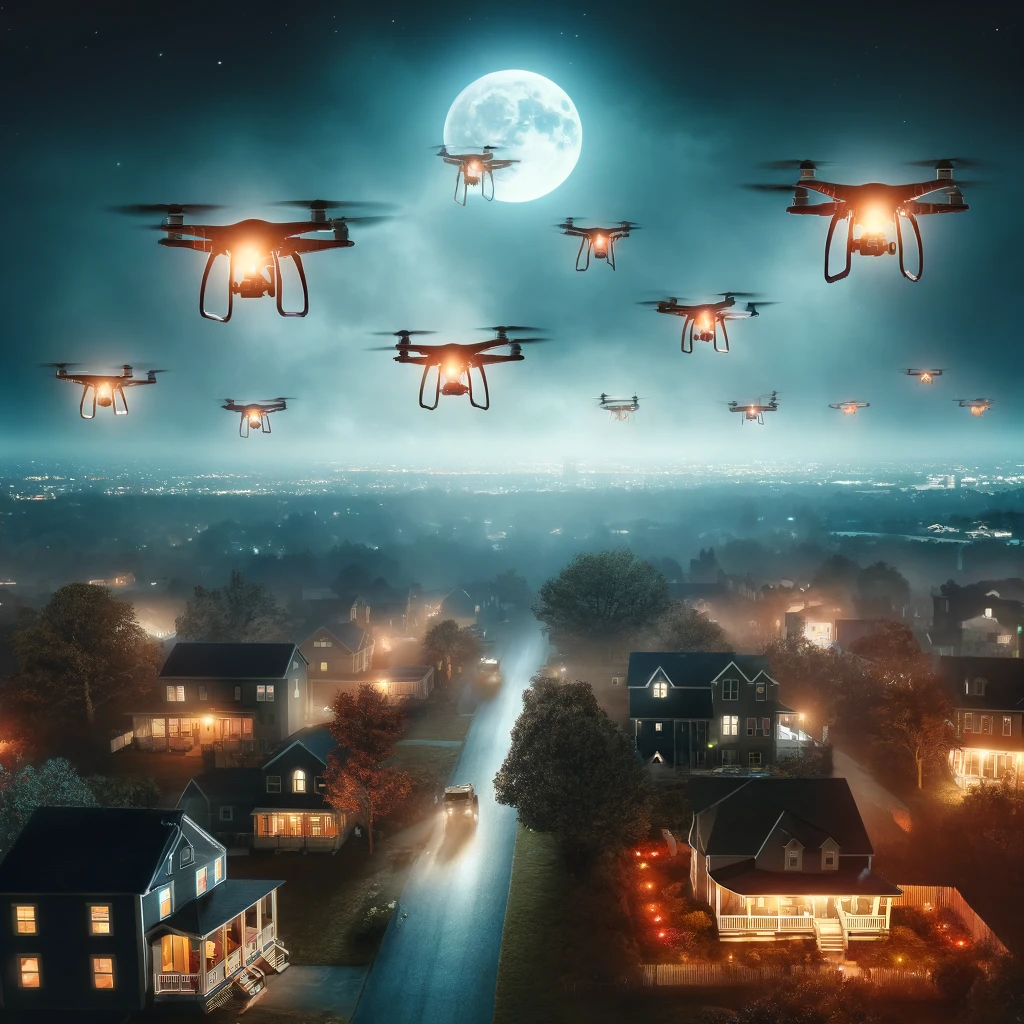
By Cybersecurity Team
on
Mystery Drones Over New Jersey: Monitoring and Mitigation
<header>
<h1>Mystery Drones Over New Jersey: Challenges and Technological Solutions</h1>
</header>
<article>
<p>Recently, there have been numerous reports of drones flying in formation over New Jersey, raising concerns among residents and authorities. These drones, some reportedly as large as a car, have been sighted in both urban and rural areas, prompting investigations from federal and local agencies. While the exact purpose and operators of these drones remain unclear, the situation underscores the urgent need for effective drone monitoring and countermeasures.</p>
<section>
<h2>Technological Challenges</h2>
<p>Unauthorized drones pose various challenges, including potential threats to privacy, security, and airspace management. Traditional air traffic control systems are not equipped to handle small, fast-moving drones, especially when their operators remain unidentified. The ability of drones to operate anonymously and in swarms complicates detection and tracking efforts, leaving authorities with limited options for immediate intervention.</p>
</section>
<section>
<h2>Technology-Driven Solutions</h2>
<p>To address these challenges, advancements in drone detection and mitigation technologies are crucial. Below are several technological solutions that could be implemented to monitor and stop unauthorized drones effectively:</p>
<ul>
<li>
<strong>Radar and Sensor Integration:</strong>
<p>Modern radar systems, combined with acoustic and infrared sensors, can detect and track drones. These systems differentiate drones from other flying objects based on size, speed, and movement patterns.</p>
</li>
<li>
<strong>RF Signal Analysis:</strong>
<p>Many drones rely on radio frequency (RF) signals for control. By analyzing these signals, authorities can identify and locate operators. Additionally, RF jamming can disrupt drone communications, rendering them inoperable.</p>
</li>
<li>
<strong>AI and Machine Learning:</strong>
<p>Artificial intelligence can analyze drone behavior patterns, predict flight paths, and identify potential threats. Machine learning algorithms can enhance detection accuracy over time by adapting to new drone technologies.</p>
</li>
<li>
<strong>Geofencing:</strong>
<p>Geofencing technology restricts drones from flying in prohibited areas by embedding location restrictions into drone software. This measure, enforced by manufacturers, is particularly effective in high-risk zones such as airports or government facilities.</p>
</li>
<li>
<strong>Counter-Drone Measures:</strong>
<p>Technologies like drone interceptors, electromagnetic pulses (EMPs), and directed energy systems can neutralize unauthorized drones. These systems require careful deployment to avoid collateral damage.</p>
</li>
</ul>
</section>
<section>
<h2>Collaborative Efforts</h2>
<p>Effective drone management requires collaboration between federal agencies, local governments, and private sector stakeholders. Establishing a national drone registry and enhancing real-time data sharing among agencies are critical steps toward ensuring accountability and swift response to threats.</p>
</section>
<footer>
<p>As drone technology continues to evolve, so must our strategies to manage and mitigate potential risks. By investing in innovative solutions and fostering cooperation, we can address the challenges posed by unauthorized drones while embracing their benefits in a controlled and secure manner.</p>
</footer>
</article>
</div>
<a href="/Index" class="back-button" aria-label="Back to blog posts">Back to Posts</a>
</article>
</main>
</div>
<aside class="col-lg-3">
<h3>Featured Posts</h3>
<ul class="list-unstyled">
<li>
<a href="/Post/welcome-to-the-world-of-cybersecurity" class="text-decoration-none">Welcome to the World of Cybersecurity</a>
</li>
<li>
<a href="/Post/understanding-the-recent-supply-chain-cyber-attacks" class="text-decoration-none">Understanding the Recent Supply Chain Cyber Attacks</a>
</li>
<li>
<a href="/Post/welcome-to-the-future-of-cybersecurity-passwordless-authentication" class="text-decoration-none">Welcome to the Future of Cybersecurity: Passwordless Authentication</a>
</li>
<li>
<a href="/Post/the-rising-threat-of-zero-day-vulnerabilities-and-how-to-protect-against-them" class="text-decoration-none">The Rising Threat of Zero-Day Vulnerabilities and How to Protect Against Them</a>
</li>
<li>
<a href="/Post/understanding-the-global-cybersecurity-landscape" class="text-decoration-none">Understanding the Global Cybersecurity Landscape</a>
</li>
</ul>
</aside>
</div>
</div>
<!-- Footer -->
<footer class="bg-light mt-5">
<div class="container text-center py-3">
<p>© 2025 www.itsapost.com. All rights reserved.</p>
<div class="footer-links">
<a href="/PrivacyPolicy" class="nav-link">Privacy Policy</a>
</div>
</div>
</footer>
<!-- Cookie Consent Banner -->
<div class="cookie-consent" id="cookieConsent">
<p>
We use cookies to enhance your experience. By clicking "Accept," you consent to analytics and marketing cookies.
<a href="/PrivacyPolicy" style="color: #00f;">Learn more</a>.
</p>
<div class="cookie-consent-buttons">
<button class="cookie-accept-btn" id="cookieAcceptBtn">Accept</button>
</div>
</div>
<!-- Scripts -->
<script nonce="WGdz2VvUNVkLRHqvA1z9RQ==">
document.addEventListener('DOMContentLoaded', function () {
function setCookieSafe(name, value, days) {
const date = new Date();
date.setTime(date.getTime() + (days * 24 * 60 * 60 * 1000));
document.cookie = `${name}=${value}; expires=${date.toUTCString()}; path=/; Secure; SameSite=Lax`;
}
function getCookieSafe(name) {
const nameEQ = `${name}=`;
return document.cookie.split(';').map(c => c.trim()).find(c => c.startsWith(nameEQ))?.substring(nameEQ.length) ?? null;
}
function loadScript(src, callback) {
const script = document.createElement('script');
script.src = src;
script.async = true;
script.onload = callback;
script.setAttribute('nonce', 'WGdz2VvUNVkLRHqvA1z9RQ==');
document.head.appendChild(script);
}
function initializeGoogleAnalytics() {
window.dataLayer = window.dataLayer || [];
function gtag() { dataLayer.push(arguments); }
window.gtag = gtag;
gtag('js', new Date());
gtag('config', 'G-LNKF0T5052');
}
function initializeClarity() {
if (typeof clarity === "function") return;
(function (c, l, a, r, i, t, y) {
c[a] = c[a] || function () { (c[a].q = c[a].q || []).push(arguments); };
t = l.createElement(r); t.async = 1; t.setAttribute("nonce", 'WGdz2VvUNVkLRHqvA1z9RQ==');
t.src = "https://www.clarity.ms/tag/" + i;
y = l.getElementsByTagName(r)[0]; y.parentNode.insertBefore(t, y);
})(window, document, "clarity", "script", "pfgcxs7qya");
}
function initializeTracking() {
if (getCookieSafe('analytics') === 'true') {
loadScript('https://www.googletagmanager.com/gtag/js?id=G-LNKF0T5052', initializeGoogleAnalytics);
}
initializeClarity();
}
const acceptBtn = document.getElementById('cookieAcceptBtn');
if (acceptBtn) {
acceptBtn.addEventListener('click', function () {
setCookieSafe('cookieConsent', 'true', 30);
setCookieSafe('analytics', 'true', 30);
initializeTracking();
document.getElementById('cookieConsent')?.classList.remove('show');
});
}
if (!getCookieSafe('cookieConsent')) {
let hasScrolled = false;
window.addEventListener('scroll', () => {
if (!hasScrolled) {
hasScrolled = true;
document.getElementById('cookieConsent')?.classList.add('show');
}
}, { passive: true });
} else {
initializeTracking();
}
});
</script>
<!-- Bootstrap JS Bundle -->
<script nonce="WGdz2VvUNVkLRHqvA1z9RQ==" src="https://cdn.jsdelivr.net/npm/bootstrap@5.3.0/dist/js/bootstrap.bundle.min.js"></script>
<!-- Tooltip initializer -->
<script nonce="WGdz2VvUNVkLRHqvA1z9RQ==">
document.addEventListener('DOMContentLoaded', function () {
const tooltipTriggerList = [].slice.call(document.querySelectorAll('[data-bs-toggle="tooltip"]'));
tooltipTriggerList.forEach(function (el) {
new bootstrap.Tooltip(el);
});
});
</script>
</body>
</html>


